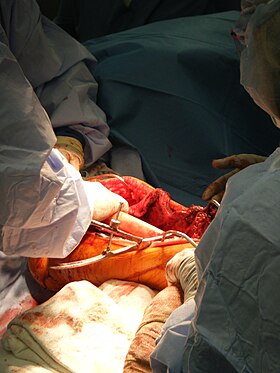
Back تطعيم عظمي Arabic Injerto óseo Spanish پیوند استخوان Persian अस्थि निरोपण Hindi Enxerto ósseo Portuguese Adiție osoasă Romanian Кісткова пластика Ukrainian Cấy ghép xương Vietnamese 骨移植 Chinese
| Bone grafting | |
|---|---|
 A surgeon places a bone graft into position during a limb salvage. | |
| ICD-9-CM | 78.0 |
| MeSH | D016025 |
| MedlinePlus | 002963 |
Bone grafting is a surgical procedure that replaces missing bone in order to repair bone fractures that are extremely complex, pose a significant health risk to the patient, or fail to heal properly. Some small or acute fractures can be cured without bone grafting, but the risk is greater for large fractures like compound fractures.
Bone generally has the ability to regenerate completely but requires a very small fracture space or some sort of scaffold to do so. Bone grafts may be autologous (bone harvested from the patient's own body, often from the iliac crest), allograft (cadaveric bone usually obtained from a bone bank), or synthetic (often made of hydroxyapatite or other naturally occurring and biocompatible substances) with similar mechanical properties to bone. Most bone grafts are expected to be resorbed and replaced as the natural bone heals over a few months' time.
The principles involved in successful bone grafts include osteoconduction (guiding the reparative growth of the natural bone), osteoinduction (encouraging undifferentiated cells to become active osteoblasts), and osteogenesis (living bone cells in the graft material contribute to bone remodeling). Osteogenesis only occurs with autograft tissue and allograft cellular bone matrices.